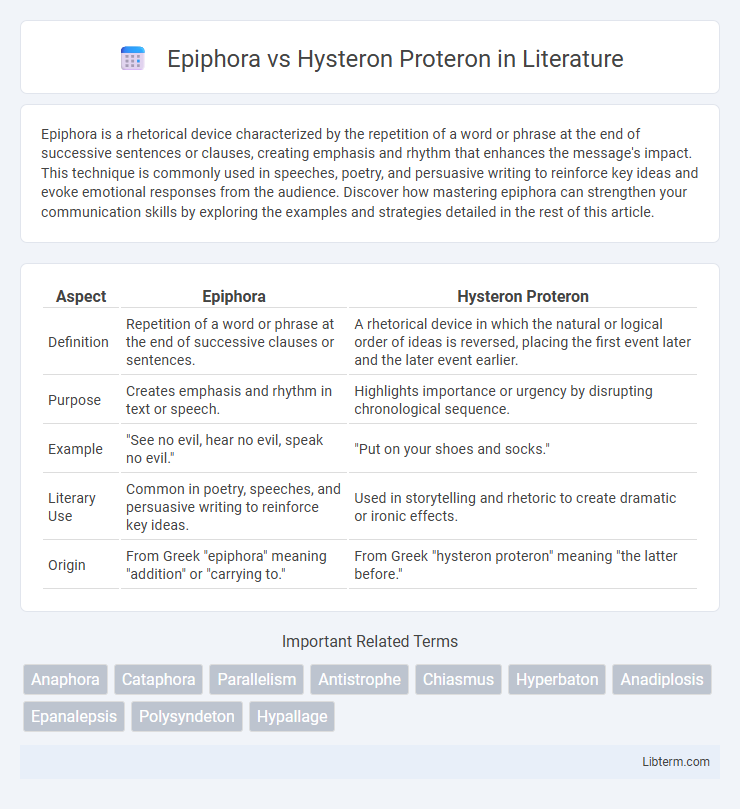Epiphora is a rhetorical device characterized by the repetition of a word or phrase at the end of successive sentences or clauses, creating emphasis and rhythm that enhances the message's impact. This technique is commonly used in speeches, poetry, and persuasive writing to reinforce key ideas and evoke emotional responses from the audience. Discover how mastering epiphora can strengthen your communication skills by exploring the examples and strategies detailed in the rest of this article.
Table of Comparison
| Aspect | Epiphora | Hysteron Proteron |
|---|---|---|
| Definition | Repetition of a word or phrase at the end of successive clauses or sentences. | A rhetorical device in which the natural or logical order of ideas is reversed, placing the first event later and the later event earlier. |
| Purpose | Creates emphasis and rhythm in text or speech. | Highlights importance or urgency by disrupting chronological sequence. |
| Example | "See no evil, hear no evil, speak no evil." | "Put on your shoes and socks." |
| Literary Use | Common in poetry, speeches, and persuasive writing to reinforce key ideas. | Used in storytelling and rhetoric to create dramatic or ironic effects. |
| Origin | From Greek "epiphora" meaning "addition" or "carrying to." | From Greek "hysteron proteron" meaning "the latter before." |
Introduction to Epiphora and Hysteron Proteron
Epiphora is a rhetorical device characterized by the repetition of a word or phrase at the end of successive clauses, enhancing emphasis and emotional impact. Hysteron Proteron involves reversing the natural order of ideas, placing what should logically come last at the beginning to create a dramatic or thematic effect. Both techniques serve to manipulate sentence structure for stylistic and persuasive purposes in literature and speech.
Defining Epiphora: Meaning and Usage
Epiphora, also known as epistrophe, is a rhetorical device characterized by the repetition of a word or phrase at the end of successive clauses or sentences to emphasize a concept or emotion. Unlike hysteron proteron, which involves reversing the natural order of events for dramatic effect, epiphora focuses on creating rhythm and reinforcing a key idea through deliberate repetition. This technique is commonly used in speeches and literature to highlight important messages and evoke a strong emotional response.
Explaining Hysteron Proteron: Concept and Function
Hysteron proteron is a rhetorical device that reverses the natural or logical order of events, placing what should come last at the beginning for emphasis or dramatic effect. This figure of speech often highlights urgency or prioritizes a particular element by presenting actions out of chronological sequence. Unlike epiphora, which focuses on repetition at the end of clauses, hysteron proteron manipulates temporal order to influence the audience's perception of importance or sequence.
Historical Origins of Epiphora and Hysteron Proteron
Epiphora traces its origins to ancient Greek rhetoric, where it was employed by orators like Cicero to emphasize repetition for persuasive impact. Hysteron Proteron, also rooted in classical rhetoric, was notably used by Aristotle to describe the inversion of logical sequence to highlight priority or importance. Both devices reflect the Greeks' sophisticated understanding of language's power in shaping emphasis and meaning in oratory.
Structural Differences Between Epiphora and Hysteron Proteron
Epiphora is a rhetorical device characterized by the repetition of a word or phrase at the end of successive clauses, creating emphasis through structural parallelism. Hysteron proteron, however, involves reversing the natural chronological order of events, placing the later action before the earlier one to highlight importance or create dramatic effect. The structural difference lies in epiphora's repetition at clause endings versus hysteron proteron's deliberate inversion of temporal sequence.
Literary Effects and Purposes
Epiphora creates emphasis and rhythm by repeating words or phrases at the end of successive clauses, reinforcing key ideas and making the message more memorable. Hysteron proteron reverses the natural order of events to highlight urgency or importance, drawing attention to the consequence before the cause for dramatic effect. Both devices enhance emotional impact and engagement by manipulating the flow and focus of the narrative.
Examples of Epiphora in Literature
Epiphora, a rhetorical device characterized by the repetition of words or phrases at the end of successive clauses, can be observed in Martin Luther King Jr.'s "I Have a Dream" speech with the repeated phrase "let freedom ring." Shakespeare's "Julius Caesar" demonstrates epiphora in the line "And that of poor citizens; and that we thirst, and that we hunger; and that we die," emphasizing the concluding words to reinforce the message. Unlike hysteron proteron, which reverses the natural order of ideas, epiphora relies on repetitive endings to create emphasis and rhythm in literary works.
Illustrative Instances of Hysteron Proteron
Hysteron proteron is a rhetorical device where the natural or logical order of events is reversed, such as in the phrase "putting on shoes and socks," where shoes are mentioned before socks despite being worn afterward. Epiphora, in contrast, is the repetition of a word or phrase at the end of successive clauses, serving a different stylistic purpose. Illustrative instances of hysteron proteron include expressions like "I die, I faint, I fail," which emphasize the outcome before preceding causes to create dramatic effect.
Comparative Analysis: Epiphora vs Hysteron Proteron
Epiphora involves the repetition of a word or phrase at the end of successive clauses, enhancing emphasis and emotional impact, while Hysteron Proteron reverses the logical order of events to prioritize importance or urgency. Epiphora strengthens a message through rhythmic reinforcement, whereas Hysteron Proteron creates a deliberately inverted sequence that challenges chronological narrative for rhetorical effect. Both devices serve distinct persuasive functions, with epiphora amplifying continuity and hysteron proteron manipulating temporal perception to highlight key ideas.
Conclusion: Importance in Rhetoric and Writing
Epiphora and hysteron proteron are powerful rhetorical devices that enhance emphasis and persuasion through repetition and unusual word order, respectively. Their strategic use heightens emotional impact and clarity, making arguments more memorable and engaging for audiences. Mastery of these techniques is crucial for writers and speakers aiming to craft compelling and effective communication.
Epiphora Infographic

 libterm.com
libterm.com